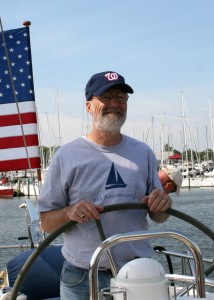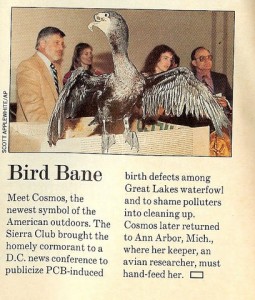
A. Blakeman Early
Commentary
By Jane Elder
I learned, with great sadness, that A. Blakeman (Blake) Early died on Sunday, Feb. 7, at the young age of 64 after a long battle with cancer. Blake worked in the Sierra Club’s Washington D.C. office for 15 years, and for most of that same span I was in the Sierra Club’s Midwest Office, heading up our Great Lakes program.
In the late 1980s I worked closely with Blake–Sierra Club’s top lobbyist on toxic pollution issues–to remake the Clean Air Act to respond to the ecological nightmares we were seeing in the Great Lakes. He is well known in Washington environmental circles for his work on the Clean Air Act, Superfund, Community Right-to-Know and other major policies.
But, I invite those of us who have labored long and hard on Great Lakes protection to pause and consider the debt we owe to this skilled and nimble crafter of some of America’s most powerful policies to clean up and eliminate toxic pollution from our environment.
When the Clean Air Act was up for reauthorization in the late 1980s, it was a time when we were finding frightening evidence in fish and wildlife in the Great Lakes that pointed to serious environmental problems. Fish-eating birds such as cormorants and terns were developing horrible birth defects.

Federal legislation that Blake Early helped pass addressed the pollution linked to developmental defects in Great Lakes cormorants and other birds. Photo: Jim Ludwig
Some were born with freakish bills where the upper and lower mandibles would be misshapen, twisted and sometimes crossed over each other in ways that meant the birds couldn’t fish and survive. There were also high levels of reproductive failure from embryos that wouldn’t develop properly in the eggs. At the same time, fish in near-shore waters near major industrial sites were developing tumors and lesions on their skin.
A handful of brave scientists in the region were putting the pieces together, and documenting that many of the suspect chemicals, from PCBs and dioxin compounds to PAHs (industrial combustion byproducts), were coming from the air. In fact, for some of the worst chemicals, as much as 90% of the inputs were coming from the air.
A push for hard evidence and a unique approach to lobbying
I took the evidence to Blake, and asked for help in re-thinking the framework for dealing with toxic chemicals in the Clean Air Act. I remember Blake asking for rigorous evidence that our concerns in the lakes were valid. I remember him shaking his head about how this was going to require approaches that would make eyes roll at EPA, and he was skeptical about whether or not Congressman Henry Waxman’s Health and Environment Subcommittee staff would take this seriously. Still, he was willing to push for us.
Blake opened doors for us on the Subcommittee, went to meetings with me where we showed pictures of the birds and fish, handed over studies, and made our case. He even helped us persuade Congressman Waxman’s Subcommittee to let us bring a live, squawking, deformed cormorant along when our scientists testified in a formal hearing on toxic air pollution.

Blake Early paved the way for the Congressional testimony of Cosmos that was reported in Life magazine.
“Cosmos” as she was known, made the pages of Life magazine in 1989 for showing up in Congress. Blake not only helped craft the legislation, he helped us spread the work by making the cormorant event possible, along with our 1988 “toxic buffet” of legally caught but still contaminated Great Lakes fish boldly labeled and presented at a Capitol Hill reception.
Beyond our work together, Blake spread the word farther. As our colleague, Dan Weiss reminded me, “In 1989 he helped get Oprah to go to Louisiana to do a show on the impact of toxic chemicals on miscarriage rates in a local community. This, too, helped make the case for broader action. And, the data from the Toxic Release Inventory that he helped create in 1985-86 arrived in 1989, and that also helped make the case for action on air toxics.”
Before 1989, America’s air pollution focus was on cars, industrial smog, and acid rain. Then, with Blake’s leadership and partnerships, a new generation of air toxics advocates eventually changed the Clean Air Act, and added a new air toxics strategy, including the “Great Waters Section” (112) in the 1990 amendments.
This section named the major toxic pollutants to the Great Lakes and other waters, and expanded EPA’s responsibilities to address air pollutants that become water pollutants, that in turn, become foodweb contamination and endanger wildlife and human health.
I wish I could say that EPA’s leadership in this area realized all our hopes, but that wouldn’t be calling it straight. Still, Blake’s early conviction helped change the notion of just dealing with toxic air pollution at the end of the pipe and opened the way for a new way of thinking about toxic contamination. That led to new domestic policy, and helped serve as a catalyst for international efforts such as the Stockholm Convention Persistent Organic Pollutants.
Gritty legislative slog yielded cleaner water, safer people, healthier wildlife
I’m always amused when I read a statement that says “In 1990, Congress amended the Clean Air Act…” as though they walked into the chambers one morning and just decided to whip something up. The gritty slog of making legislation requires skill, tenacity, almost a clairvoyant understanding of the process, and the ability to get along with all sorts of people and opinions, while staying focused on achieving your goals.
Blake was a master at this game, and people are safer, our waters cleaner and our fish and wildlife healthier because of what he gave to his work and passions. Blake, who loved sailing, was one of our best navigators on legislative battles that grappled with environmental quality and the impact of pollution on innocent victims.
One person can make an extraordinary difference in the quality of our lives. I am honored to have worked with Blake.
A memorial service for Blake Early is at 11 a.m. Saturday, Feb. 13, at Christ Church, 118 North Washington Street, Alexandria, VA. Gifts to honor his memory and continue his life’s work of clean air advocacy may be made to the American Lung Association National Headquarters at 1301 Pennsylvania Ave NW Suite 800, Washington DC 20004
Thank you Blake for being an environmental ambassador to the Fresh Coast!
Great piece, thank you for writing it.